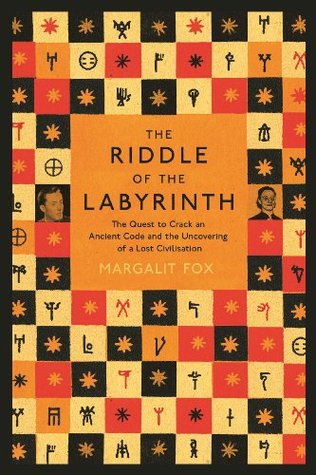 The Riddle of the Labyrinth, Margalit Fox
The Riddle of the Labyrinth, Margalit Fox
This book discusses the decipherment of the Minoan script, Linear B. I didn’t know much about it before I started reading this; I’ve read pretty often about Champollion’s work on hieroglyphs, though not in the detail given here, and it’s the kind of thing that always fascinated me as a kid. So I was intrigued by this right away, especially because it promised to bring the work of a more obscure female scholar into the foreground. Fox definitely wants to highlight the work of Alice Kober, who she seems to hold in great affection, but there is quite a lot of space dedicated to the discoverer of Linear B, Arthur Evans, and the man who ultimately deciphered it, Michael Ventris.
It’s a thorough explanation of the decipherment, so perhaps not for the faint of heart, and it never pretends that the contents of the tablets were expected to be (or found to be) particularly glamorous: it was obvious from the start that the tablets would prove to contain inventories, not great literature. The glamour is in the mystery, which for a long time was completely locked: the language wasn’t known, the script wasn’t known, and the contents weren’t known. It was very hard to get a grip on how to extract meaning. Arthur Evans never did; he seems to have locked onto what he thought the answers would be, and gone looking for evidence. Ventris did the same, initially. Kober, of the three, was the one who really began on the right track: she studied all sorts of languages to understand how languages in general work, and she did painstaking work on the statistics, until the facts began to emerge for themselves.
The book also includes the life stories of the three scholars, particularly Kober and Ventris. It was fascinating to read about Kober and her determination, and her career in academia in the 40s; the hopes and setbacks she experienced. I can understand Fox’s fascination with her. It sounds like she was a great teacher and a passionate person, for all that you can peg her for the dried-up-spinster stereotype.
Some of the technical details of the decipherment were a bit beyond me — statistics and anything to do with numbers just don’t stick in my head — but I enjoyed this anyway. It’s a thorough account, which shines some light on a deserving person (Kober) whose contribution has been neglected.
Rating: 4/5

I always wondered how these people decipher ancient scrips. I hate technical details, generally, but I’m actually glad to read they’re there. Maybe because I’m a writer myself I’m more interested in the technical details of langauge than, say, physics.
Yeah, it’s good to know that there are (at least somewhat) accessible books out there explaining processes like this!